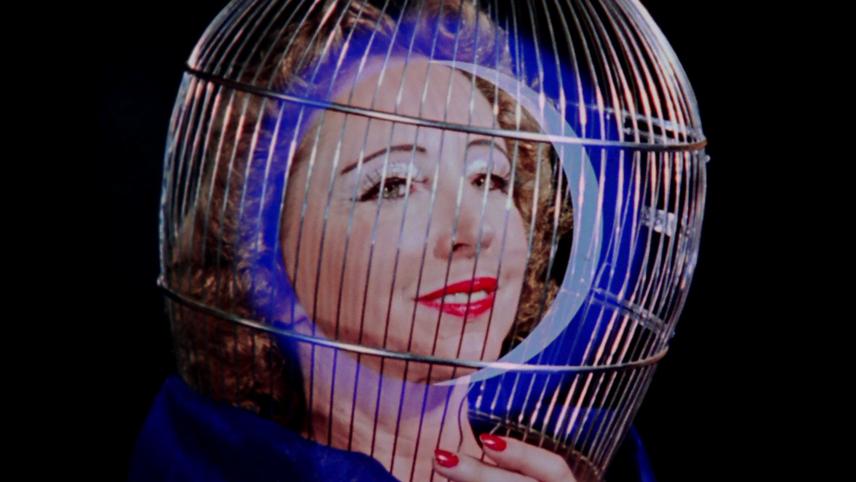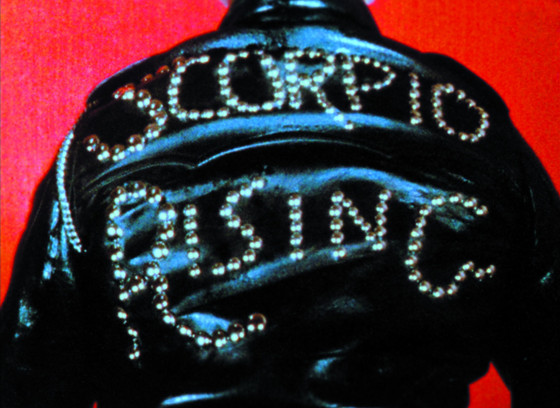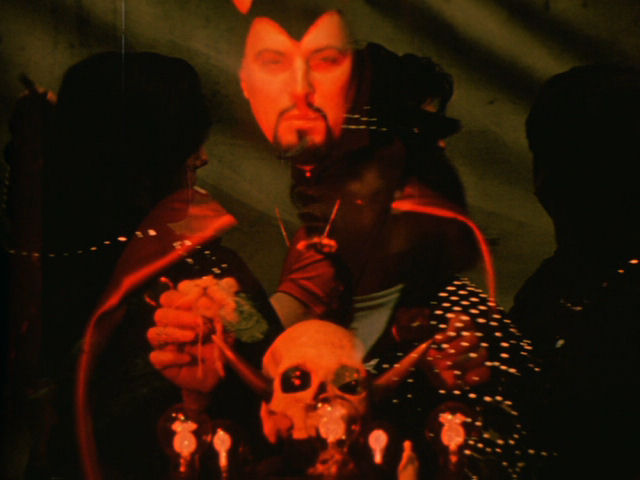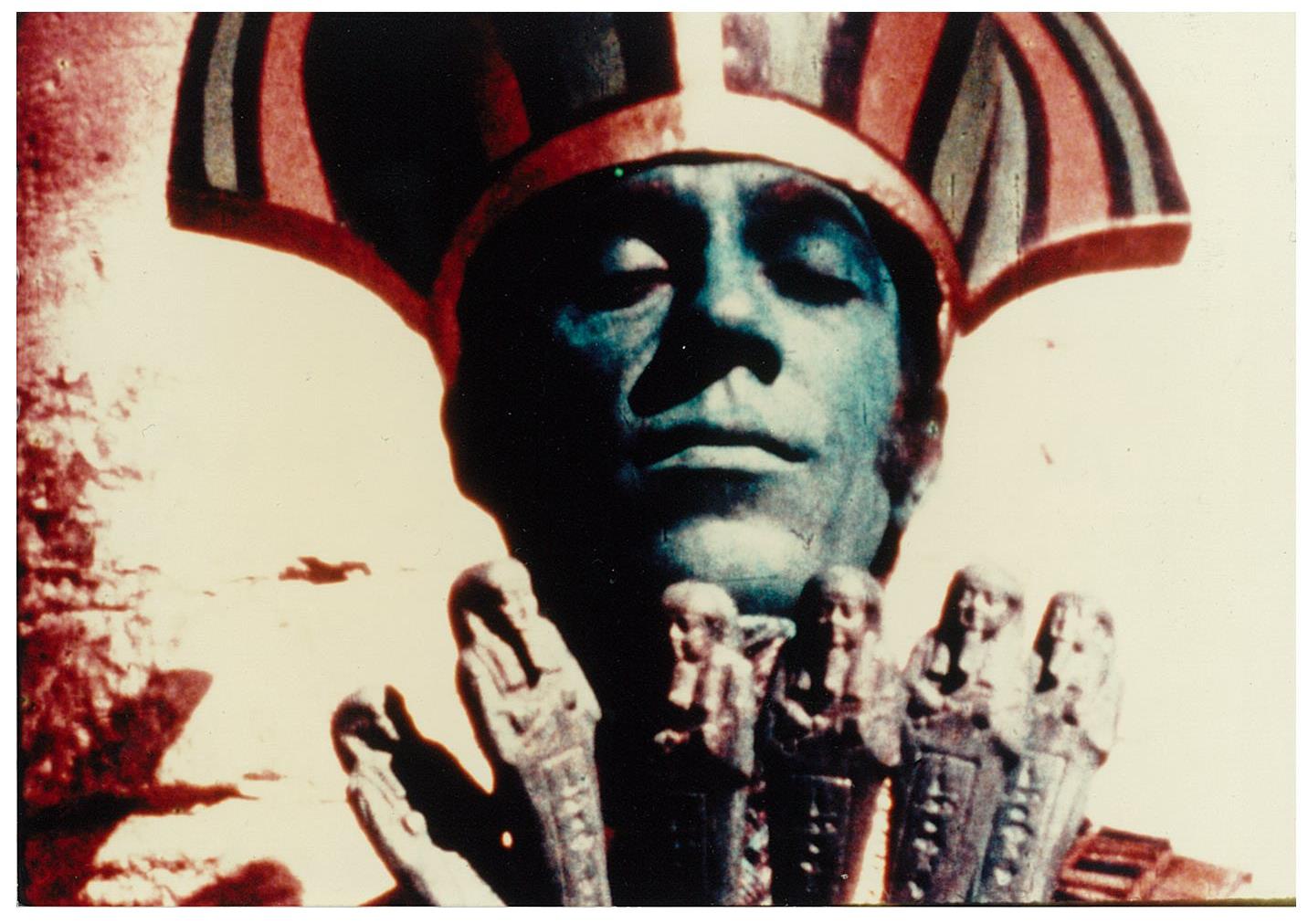What might be the most moonlit jewel in Anger’s Magick Lantern Cycle, certainly his most celebrated film, is 1954’s astonishing Inauguration of the Pleasure Dome.
Taking its moniker from Samuel Taylor Coleridge’s opium-influenced poem, Kubla Kahn, Anger was also fittingly influenced by “Come As Your Madness”, an illustrious costume gala hosted annually in the Hollywood mansion of the famously isolated impresario Samson De Brier (the same silent film star who let Anger shoot Puce Moment in his abode).

Using layered images, frequently crass uses of colour, and mosaic-like superimposed visuals in a kaleidoscopic quilt of emblems and magical conjurations, Inauguration is a living, breathing incantation. In his own words, a “Dionysian revel”, Inauguration also communicates Anger’s affection and enthusiasm for Thelema.
While the critics of Aleister Crowley, and there were many, mostly puritans, Christians, and uptight insular types, forever dubbed him “the wickedest man in the world” (an inaccurate proclamation which Crowley fully endorsed as it helped his popularity soar and no doubt drove more people towards his fascinating philosophy), Anger and many of his peers found his brand of western esotericism invigorating, and exciting.
Much of Inauguration plays out as the Gnostic Mass, a narrative ritual full of imagery and symbolism that details not only the Tree of Life, the eucharist, a many chorused constellation of gods, and, perhaps most surpassingly, a “Scarlet Woman”––a nom de plume Crowley would confer only to chief magical partners––portrayed in the film by the enigmatic beauty, Marjorie Cameron.
Cameron, a legend in occult circles as well as an actress and artist of great vision and intellect, wasn’t the only epochal figure to appear in the film. The celebrated author Anaïs Nin, scribe behind such classics as Delta of Venus and Little Birds, plays the role of Astarte, Greek goddess of fertility, sexuality, and war.
De Brier himself stars in multiple roles, which include Crowley, Cagliostro, Nero, Osiris, and Shiva. Curtis Harrington, who had previously shot Puce Moment for Anger was now in front of the lens in the eerie role of Cesare, the Somnambulist (a straight up reference to Wiene’s expressionistic classic The Cabinet of Dr. Caligari).
Inauguration has been reworked several times by Anger over the years so that no one definitive version exists, which is, itself, in keeping with the living, evolving, and transmutative nature of both magical practice and, let’s face it now, the human condition.
Ostentatious at times, Inauguration of the Pleasure Dome often looks, feels, and sounds like an Expressionist song-and-dance talent show at a house party in the abyss. And it’s every bit as awesome as that description sounds.
What’s the Frequency, Kenneth?

1964 found Anger fresh from France, eager to document and detail the fetishized, ritualistic, leather-adorned and adored lives of an all male Brooklyn chapter of Hell’s Angels. While also celebrating the deification of iconic rebel figures James Dean and Marlon Brando, Scorpio Rising was another underground sensation for Anger.
Through the artful and assuming use of montage and jukebox assorted soundtrack (full of 60s nonpareils by the Angels, the Crystals, Ricky Nelson, Elvis Presley, Bobby Vinton, and others) Scorpio Rising would prove to be another astonishing and litigious work.
Like so many of Anger’s other films, Scorpio Rising was met with hostility and fury, at least amongst the philistines who didn’t know how to react to art when presented with it. At its premiere in New York City, at the Gramercy Arts Theatre, the manager there was charged with public obscenity and police canceled the film’s run.
Eventually, a California Supreme Court would side with Anger while defending the film as a work of art, even if it contained brief flashes of genitalia and homoeroticism writ large, all to the chagrin and frustration of the pious and the boring, of course.
“[Scorpio Rising] was a movie of such extreme purity that it surprised me, almost shocked me. Every cut, every camera movement, every colour, and every texture seemed somehow inevitable, in the same way that images of the virgin in renaissance painting seem inevitable—in other words, pre-existing but dormant, and brought back to life through some kind of invocation. The layered imagery and the music were completely contemporary, but the sensibility wasn’t. It seemed as if nothing else existed, as if everything else had been wiped clean, and we were seeing the first images—totemic, talismanic images.”
– Martin Scorsese

Kustom Kar Kommandos (1965) turns a soft focus and honeysweet peek towards SoCal hot rod culture. As the Paris Sisters coo their desire to have a dream lover, “So I don’t have to dream alone…” a joyful young man (Sandy Trent) buffs and shines his custom car.
With an inchoate cotton candy pink background, the framing, angles, strokes and movements of Trent’s body over the agleam automobile, Kustom Kar Kommandos all but screams agonizing autoeroticism, that it is a scant three minutes is another demonstration of Anger’s expert reach.
1968’s nightmarish Invocation of My Demon-Brother is an unsettling and simmering distillation of newsreel footage from Vietnam, the Haight-Ashbury counterculture, close to collapse at this point, and a Satanic ritual conducted by Anger and a puffed up Anton LaVey.
An appearance by Bobby Beausoliel, skyclad and celestial, filmed not long before he would take part in the Manson family killing spree – murdering Gary Hinman under instructions from Charles Manson – that would forever maculate an otherwise enlightened era, haunts and hounds the film along with Mick Jagger’s Moog heavy score. Trance-like and menacing, Invocation is a demoniac death song, also notable for turning Nazi motifs into high camp.

“You can express yourself as well in five minutes as three hours. I’m basically a short filmmaker. I’ve never had the big, big grants. I could use $250,000 from the MacArthur Foundation, sure. But mostly I make ‘cine-poems’.”
– Kenneth Anger
Beyond Our Ken
Beausoliel would return for another alliance with Anger, in Lucifer Rising (1972). Though for Beausoliel’s part, the footage of him was previously shot before his arrest with the Manson family (using some sequences previously read in Invocation of My Demon-Brother) while his LSD-addled, space age attuned guitar feedback bombast soundtrack was recorded from prison.
Easily Anger’s most ambitious and expansive film, Lucifer Rising was an elaborate production filmed largely in Egypt with Anger playing the role of the Magus, Marianne Faithfull as Lilith, Chris Jagger (Mick’s brother) as the Man in the Yellow Tunic, Scottish filmmaker Donald Cammell as Osiris, and Myriam Gibril as Isis, rounding out the cast.
Alien spacecraft, Egyptian symbolism, and locales pertinent to Crowley’s famed The Book of the Law, regarded as the sacred text of Thelema, populate and navigate the film. Lava flowing, skies swollen with storm clouds, glimpses of Stonehenge and the Great Pyramids compete with cobras, crocodiles, and stampeding elephants, all mid magick formula, a blue-skinned Faithfull (looking authentically strung-out), green-fleshed Cammell, the genealogical Sphinx, all enigma and ancient, everything alien and oracle.

“Every man and every woman is a star.”
– Aleister Crowley
Anger’s Magic Lantern Cycle certainly transcends its time and its place, but it would be a delusion to discount either. Social tensions and the counterculture influenced these films as much as Anger’s own psychic agenda.
Experimental films of this nature may not necessarily contain traditional narratives or be considered great love stories with browbeaten lovers clutching emptiness, their bruised hearts in twain. But that isn’t to say the figures herein, fraught with anguish, faces pained or enraptured, bodies bent and brave, are poised between perfection and flight, are ageless and alive.
Author Bio: Shane Scott-Travis is a film critic, screenwriter, comic book author/illustrator and cineaste. Currently residing in Vancouver, Canada, Shane can often be found at the cinema, the dog park, or off in a corner someplace, paraphrasing Groucho Marx. Follow Shane on Twitter @ShaneScottravis.